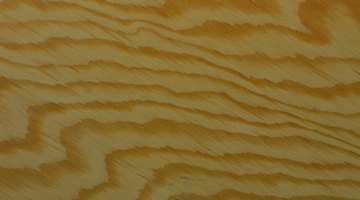Fir Vs. Pine Plywood
Not all plywood is created equal, and selecting the wrong type of plywood for a particular job can be disastrous, due to the water damage, insect infestation or lack of structural integrity that may result from choosing the incorrect plywood.

Understanding the strengths and weaknesses of various species of wood and how plywood is put together will ensure that the right wood is used for the job.
What Is Plywood?
Plywood is a general term for engineered lumber, which is almost always made up of several species of wood. Each layer, or "ply," of a sheet of plywood is glued to the other with the grain running perpendicular to each connected ply. This provides a great deal of strength for the overall sheet. When a sheet of plywood is labeled "fir plywood," for example, this refers to the species of the outer plies, where the inner plies may be a lesser-grade wood.
Fir Plywood
Fir plywood is often used for interior sheeting on floors, enclosures and some walls. Fir does not have natural insect resistance once it has been hewed. Fir is a strong wood, and a relatively affordable species, as it is quite common. This makes the plywood less expensive to produce and acquire, and thus quite popular for use in construction when used in the appropriate locations.
Pine Plywood
Pine plywood is rarely actually "plywood" at all. Pine is most often found in solid sheets, but may still be referred to as "plywood," simply indicating that it is a large sheet of pine. Pine is a plentiful wood, and inexpensive, but it is also quite soft and vulnerable to water damage, making it unsuitable for general construction purposes. Pine is most often used for furniture and cabinets in areas not exposed to water or extensive temperature fluctuations.
Other Types of Plywood
Other varieties of plywood are readily available at most lumberyards and home improvement stores. Some varieties have very attractive hardwood veneers — that is, the outermost "ply" is a hardwood species such as oak or birch. These varieties are suitable for paint or stain and are quite common in cabinet and furniture construction.
References
Writer Bio
Based near Seattle, Josh Hulbert has been working in technical and leadership roles since 1998. He has authored technical articles for various online and print publications, and consulted for several major tech companies. Hulbert holds a B.A. in mathematics and a B.S. in computer science, as well as several industry certifications. His areas of expertise include software, security and infrastructure design.
Photo Credits
- Photos.com/Photos.com/Getty Images
- Photos.com/Photos.com/Getty Images
More Articles



